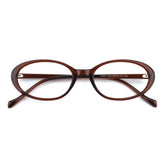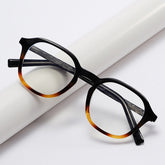How to Adjust to Bifocals and Progressives?
Almost all of us experience presbyopia in middle age. You’ll know it’s happening when have to hold your favorite book, the daily newspaper, or a restaurant menu farther away just to read it.
If the vision becomes blurry when looking at a phone or book but still appears clear in the distance, reading glasses may be helpful. But if you’ve always worn glasses, multifocal lenses may be helpful. Wearing progressive/bifocal lenses can simultaneously meet the visual needs of driving, computer, and mobile phone, avoiding frequent changes in glasses.
- What are bifocal and progressive lenses?
- What is the difference between progressive and bifocal lenses?
- What side effects will they have when you first try progressive and bifocal lenses?
- How to adjust yourself to bifocal and progressive lenses?
- What are the requirements of progressive and bifocal for the frame?
1. What are bifocal and progressive lenses?
- Progressive lenses: There is no boundary line on the lens, and the degree gradually changes from top to bottom (far-middle-near).
- Bifocal lenses: The lenses are divided into upper and lower areas, with a clear boundary between the upper and lower areas, allowing for a distant view and a closer view.
- The core principle of the progressive lenses and bifocal lenses is to achieve a smooth transition of degree through the continuous gradient of lens curvature, but there may be blurriness.
2. What is the difference between progressive and bifocal lenses?
- Progressive lenses are suitable for dynamic eye use scenarios, such as office and daily life. Bifocal lenses are more suitable for static scenes auch as reading and driving.
- Progressive lenses can achieve correction of three visual angles: far, medium and near. Bifocal lenses can only correct far and near vision. Lack of mid-range adjustment may cause blurry computer screens.
- Progressive lenses have no dividing line, so they are suitable for people who have appearance requirements and those who pursue natural vision. And bifocal lenses have a boundary line, so the conversion between near and far is more direct, which is friendly to people with weak adaptability.
- Although progressive lenses and bifocal lenses have different designs, they both belong to multifocal lenses and are mainly used to correct presbyopia, helping users to see objects at different distances from far, medium, and near simultaneously.
3. What side effects will they have when your first try bifocal and progressive lenses?
Although bifocal/progressive lenses can meet the needs of far, medium, and near vision simultaneously, there may be some side effects associated with early or even long-term use.
- Dizziness or imbalance. When walking, the ground feels undulating.
- Blurred or distorted peripheral vision.
- "Partially clear". The vision is divided into three parts, and the clear area becomes smaller.
- Unclear mid-range vision. When looking at the computer, the text will be blurry.
- Driving at night will cause glare. The halo of streetlights makes the view on both sides even more blurry.
- Long adaptation. Some people need 1-2 weeks to adapt, a few need more than 1 month.
4. How to adjust yourself to bifocal and progressive lenses?
Adapting to bifocal or progressive lenses requires some time and skills, especially when you first try it. Here are some practical suggestions to help you adapt faster:
- Persist in wearing it for at least 4 hours every day: the adaptation period usually takes 1-2 weeks or even longer, and intermittent wearing can prolong the adaptation time.
- Avoid frequent replacement of old glasses: Unless you experience severe dizziness or nausea, try to continue using new glasses as much as possible.
- Adjust eye habits: Try to align the center of the screen with the distance zone of the lens. When looking into the distance, look up or slightly lift your head, and see the distance through the upper part of the lens. When looking at your phone or book, lower your head and use the lower part of the lens. When using a computer, adjust the screen height to align your gaze with the middle area of the lens.
- Turning the head instead of turning the eyes: There are blind spots on both sides of the progressive/bifocal lenses, so do not look sideways at objects next to you. Actively turn your head to avoid a sense of imbalance. When going up and down stairs, lower your head slightly to ensure that you can see the steps clearly through the lens's far end area.
- Adapt in stages: Wear it in a safe and familiar environment to alleviate dizziness symptoms, and then gradually transition to outdoor or complex environments. Avoid prolonged walking or driving in the early stages until fully adapted.
- Raise the frame: For cases of blurred vision, lift the nose support of the glasses to make it easier to align the “near" area with the line of sight.
- Dizziness/nausea symptoms usually subside within 1-3 days: If they persist for more than 1 week, it is necessary to check the optometry data or lens design for suitability.
- Use specialized glasses for night driving: For night glare, single-vision distance or reading lenses can be used.
- Anti-fatigue lenses or bifocal lenses: If the side effects of progressive lenses are unbearable, anti-fatigue lenses or bifocal lenses can be considered. Anti-fatigue lenses refer to low-degree progressive lenses (ADD +0.75~+1.25), suitable for people with mild presbyopia. And the bifocal lens abandons the adjustment of medium distance, making the switching between near and far more direct.
5. What are the requirements of progressive and bifocal for the frame?
- Adequate frame height: For bifocal lenses, it is necessary to ensure that both the far and near areas can fully cover the pupil. Therefore, it is recommended to choose a frame with a frame height of ≥ 28mm when purchasing bifocal eyes. For progressive lenses, they are divided into three areas: far, middle and near, so it is recommended to choose a frame with a frame height of ≥ 30mm.
- Support: It is advised to choose a frame with an adjustable nose pad when selecting glasses, ensuring that the optical center of the lens is aligned with the pupil.
- Stability: When selecting a frame, you can prioritize choosing full frame or half frame to avoid frameless or thin frame frames that are prone to slipping.
- Shape: Avoid choosing frames with excessively curved shapes (such as cat glasses), as this may lead to the expansion of the astigmatism area.
Patience is key. Most people can eventually adapt to bifocal or progressive lenses and enjoy their convenience.











